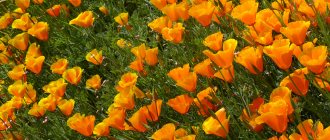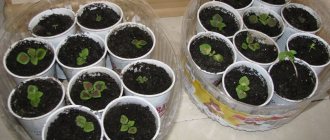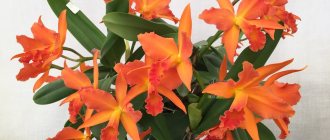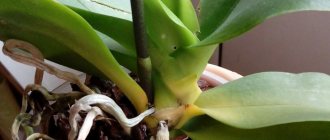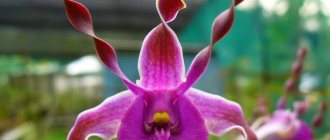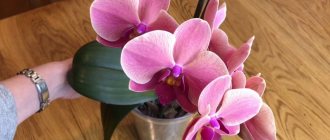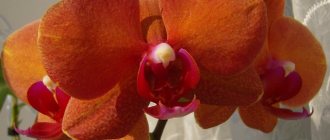Plants » Flowers
0
1681
Article rating
Kira Stoletova
There are probably no flower growers who would not be attracted to the magical and mysterious plant - the orchid. The Emperor's Pearl orchid is a monopodial epiphyte, large with a beautiful and lush color.
Emperor's Pearl Orchid
Description
The Emperor's Pearl orchid (Phalaenopsis Emperor Jewel), also called Phalaenopsis Jewel, is a monopodial epiphyte .
The height of the stem is up to 40 cm. The leaves are arranged in two rows, dark green, fleshy, length from 15 to 30 cm, width up to 10 cm. The peduncle is long, more than 60 cm. The inflorescence is multi-flowered, branched. The flowers are large, from 6 to 8 cm. The color is dark crimson, the color becomes lighter at the edges and in the middle of the flower.
The flowers are odorless . The plant blooms almost all year round. Most abundant from February to November.
Types and varieties of Ludisia with photos and names
220 species of precious orchids on the planet . Among such a large number, only a few can be grown at home.
The most popular types:
Ludisia discolor
This plant is often called colorless or multicolored ludizia . The stems are twisting and creeping. Peduncle erect. It is capable of growing up to 20 centimeters in height.
The flowers of the plant are small and white . The lower ball of the leaves resembles a so-called oblique lip. It is above them that yellow anthers form.
Ludisia discolor emerald velvet
The plant belongs to the subspecies of Ludisia velvet . The leaves have an elongated shape and are shiny. The color of the plates is emerald green. Along its entire length there are clearly visible yellowish stripes . The stem is silvery in color and smooth in shape.
No less popular is Ludisia tanlaniana . The plant differs in the width of its leaves. Adult plates can grow up to 5 cm in width. In the center of the leaves there is a pattern in the form of a light green mesh.
How to grow from seeds?
Growing an orchid from seeds is very difficult. This may take 5-6 years. Seeds are also not so easy to get; they are not available in a regular flower shop. They are most often ordered through online stores. They come from China. You need to purchase containers with screw-on lids that can withstand high temperatures.
Preparation of nutrient medium
Compound:
- 1.5 g fertilizer NPK 20-20-20;
- 20 g sugar;
- 1g crushed activated carbon;
- 5 drops of phytostimulant (such as Epin);
- 1 liter of distilled water;
- 8 g Agar-agar.
- Boil 500 grams of water. Add sugar and agar-agar.
- Cook over low heat until the agar-agar is completely dissolved.
- In another container, heat the remaining water to about 80 degrees. Add fertilizer and coal.
- Combine the two solutions.
- Pour into sterilized jars, 2cm each.
Substrate sterilization
- Take a wide saucepan, put a cloth or towel in it, put jars in it and fill them up to the neck with saline solution (2 tbsp. salt per 1 liter of water). Boil for half an hour.
- Leave for 7 days at room temperature.
If mold does not appear, everything was done correctly.
Sowing
- Take a weak solution of bleach 0.5%, treat all working surfaces, jars, pipette, gloves, seeds.
- Use a pipette to transfer the disinfected seeds into the nutrient medium.
- Place in a warm, not very dark place for 2 months.
- Then the sprouts need to be moved to another substrate. The recipe is the same, only 30g of crushed banana is added to it.
- When transplanting, everything is still treated with a chlorine solution.
- After a couple of months, young plants can be transplanted into orchid substrate, where there is more moss than bark. Fertilize with phytostimulants.
Table: Seasonal growing conditions
| Season | Temperature | Lighting | Humidity |
| Spring | The precious Ludisia orchid in nature can withstand a wide temperature range - from 10 to 39°C. The innate hardening of the flower allows it to be successfully grown in both cool and hot conditions. But in order to create the most comfortable atmosphere for the orchid, it is necessary to maintain a temperature of about 25°C in the summer. At night this figure should be approximately 3–4°C. | Ludisia prefers partial shade or diffused light. Sunlight, especially during the midday period, is definitely not suitable for the plant. But the sun's rays in the morning or evening hours are quite acceptable. Usually Ludisia is placed in the back of the room or near windows in the western and northern directions. If an orchid is grown under artificial light, then the duration of illumination is increased to 12–14 hours a day. | Ludisia can tolerate dry air, but it should not be tormented. To maintain the decorative qualities of the orchid, it is best to provide a sufficiently high humidity - 70%. If you do not have a special humidifier, you can spray the orchid and the air around it, cover the pot with wet moss, or place it on a tray with moistened filler. Ludisia will feel very good near the home fountain. You will have to especially try in the summer heat and with heating devices on. During the period of active growth, you can remind Ludisia of warm tropical rains by placing her under a warm shower (not higher than 35°C). After completing the procedure, lightly blot the leaves with a napkin and let them dry. Varieties with velvet leaves require increased attention in terms of spraying. Water may leave whitish streaks on the leaves. Spraying is carried out only with boiled or distilled water. Rain or melt is very good. |
| Summer | |||
| Autumn | The temperature for winter keeping is lower - about 18°C. The limit is a threshold of 14°C; a lower value could cause the death of Ludisia. | It is advisable to illuminate the plant in winter using phytolamps or ordinary daylighting devices. | |
| Winter |
If Ludisia is grown in a florarium or orchidarium, then throughout the year it is necessary to maintain the temperature within 20–22°C (with a decrease at night to 18°C).
Transfer
- Pot . The size of the pot depends on the roots of the flower. If the plant has outgrown the previous pot, you need to take a new one 1 cm larger. There must be several holes at the bottom of the pot.
- Substrate . Regular soil is not suitable for orchids. You can buy a ready-made substrate; it is sold at any flower shop. You can prepare it yourself: crushed pine bark, heated in the oven, sphagnum moss, peat.
- Landing.
- Carefully remove the plant from the old pot, shake off the roots from the substrate.
- Inspect the roots. Leave green, light yellow and white ones, and cut off dark, dry ones.
- Sprinkle the cut areas with crushed charcoal.
- Place expanded clay or large pieces of bark at the bottom of the pot.
- We fill the plant with substrate to the level of the leaves. We water it.
Why do the leaves of the Ludisia orchid turn red?
The first reason for discoloration of the plates is improper watering . If you water your flower frequently and abundantly, the lower leaves will first turn red and then dry out. In this case, it will be enough to adjust the watering.
of old plants may also turn red . The only way out of this situation is to transplant the orchid.
If you follow all the rules of care, the plant will have a neat and attractive appearance.
Care
- Light . The orchid develops well in partial shade. If the leaves turn yellow, there is too much light. If the leaves are too dark and grow poorly, there is not enough light.
- Temperature . The Emperor's Pearl loves a comfortable room temperature of 20-23 degrees.
- Watering . Once a week is enough. If the room is cool, replace watering with spraying. When watering, do not touch the leaves. Wipe the leaves with a damp cloth to remove dust.
- Fertilizers . Orchids need phosphorus, potassium and nitrogen during their growth period. It is better to use ready-made special fertilizers. They have the right ratio of nutrients.
- Transplant . It is done only when the substrate has oxidized, or when the pot has become small. Transplantation is stressful for phalaenopsis.
- Diseases . They appear as spots on the leaves or plaque on the soil. Most often, this is a fungal disease and can occur due to overwatering and poor drainage. The plant should be removed from other flowers, the substrate should be replaced, diseased roots should be cut off, treated with charcoal or activated carbon, and the plant should be sprayed with Fitosporin until the symptoms disappear.
- Bloom . An orchid may not bloom for a long time if it is watered with cold water, or if there is too much water.
Pests
Inspect the leaves for pests every time you water. Immediately after purchase, place the phalaenopsis pot in a container of water. This will clean the flower from possible pests. A variety of centipedes, spiders, cockroaches, woodlice and earthworms usually live in the substrate. The plant itself can be affected by aphids and mites.
Remove all scales, old leaves, and dried pseudobulbs in a timely manner. Treat the plant with soapy water, remove insects manually, Fitoverm helps a lot, treat the plant with it according to the instructions. During prevention, it is advisable to wash and wipe the leaves dry, and rinse the substrate under running water.
Reproduction
- The emperor's pearl reproduces after flowering. A baby appears. When a baby develops aerial roots, it can be transplanted from an adult plant.
- An adult plant that has more than 6 leaves and many aerial roots can be divided with pruning shears. Treat the cut with charcoal and transplant the two parts into different pots.
Growing and caring for the Emperor's Pearl orchid is quite a complicated matter . But this work is justified, since it will delight you with its flowering all year round.
When does Ludisia bloom?
Flowering can be observed from late autumn to early winter . This feature of the plant allows you to enjoy the beauty of the buds at a time when other flowers are already preparing for winter rest.
The flowering period of Ludisia is about a month. At this time, you need to pay special attention to watering. When carrying out this procedure, you need to ensure that water does not get on the leaves and flowers .
This video talks about the wonderful flower - ludisia, as well as the experience of growing it.
Lighting
These magnificent plants are light-loving, but at the same time they need diffused lighting. Beginner gardeners often ask: “Why do the leaves of precious orchids turn pale?” One of the reasons for this is excessive lighting and direct sunlight on the plant. For example, goodyear and makodes feel more comfortable in shade. These flowers actively grow and develop even in full artificial light, as in natural light.
A special feature of these flowers is the ability to grow using only lighting, which will replace the usual mode of maintenance. This allows you to place them not only traditionally on window sills, but also in dark rooms (in the bathroom, for example).
It is noteworthy that precious orchids themselves signal about excess or lack of lighting. Their care should vary depending on the behavior of the plant. For example, if the leaves turn pale, are too dense in an upright position, or are uncharacteristically drooping, this means that the lighting is too intense. If there is not enough light, the leaves become smaller, are rarely located on the shoots, and the internodes lengthen.
Anectochilus
This miniature orchid has several other names - anectochil, anectochilus. It does not exceed 15 cm in height. The anectochilus orchid has golden or silvery veins on greenish-brown or green leaves. They resemble cracks and perfectly emphasize the glossy texture of the surface and the regular shape of the ovoid leaves.
Sometimes there are so many veins that it is difficult to determine the base color. The leaves are larger than those of makodes. The anectochilus orchid forms a rather dense rosette. But what is especially surprising about this variety is the tall, sometimes seemingly disproportionate inflorescences in relation to the plant, which are a lush cluster of white flowers. The most popular of this variety are:
- Anectochilus Roxburgh.
- Beautiful.
- Royal.
- Striped.
Much less common in private collections is Anectochilus Sikkim, which today has been renamed Anectochilus short-lipped. Anectomaria is very attractive - a hybrid that does not require too complicated care and does not need a rest period.




